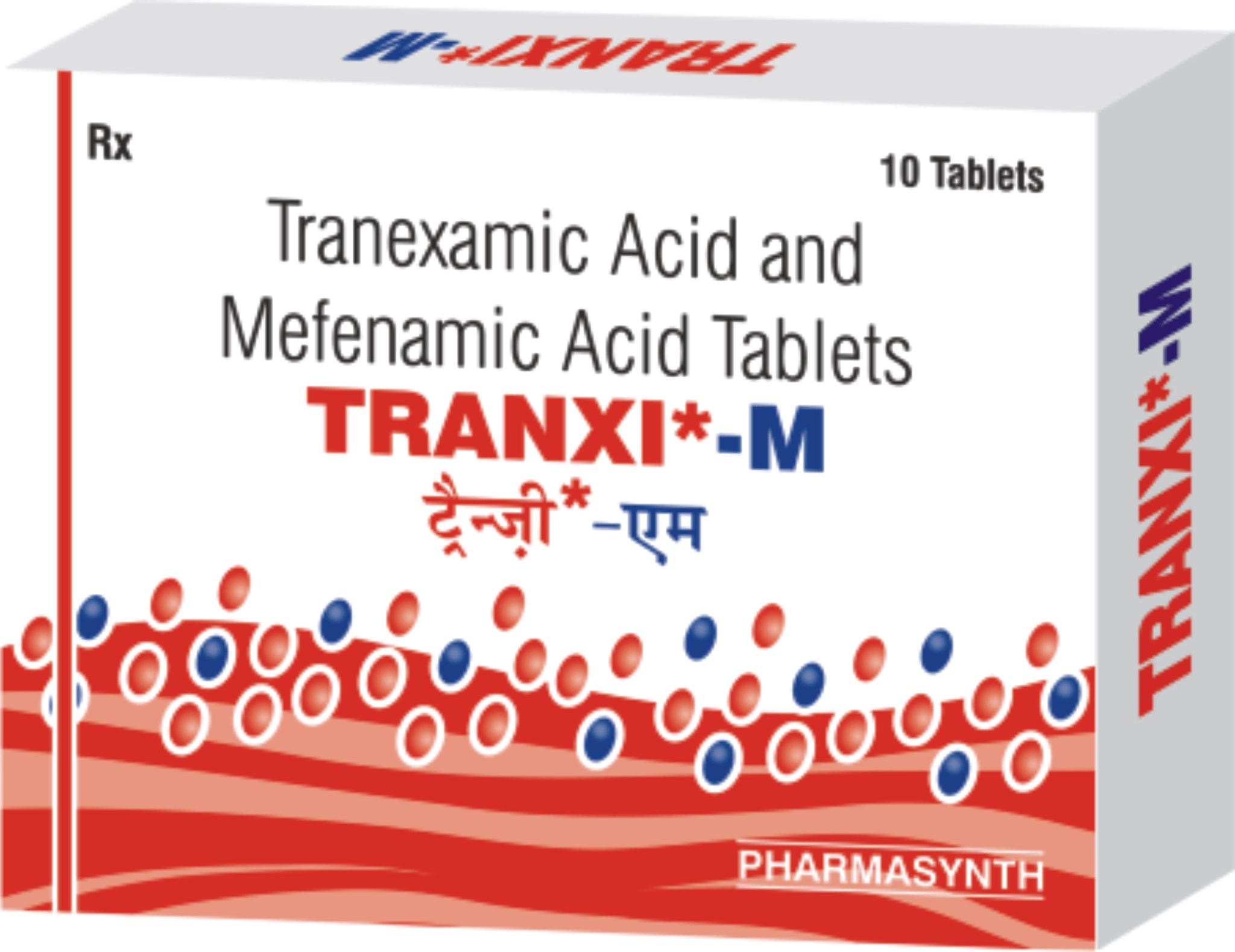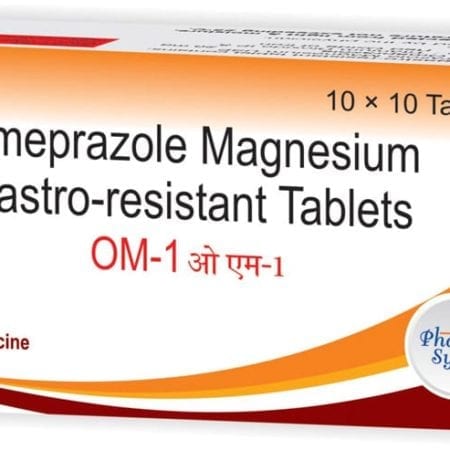TRANXI-M
.:: COMPOSITION ::.
Each film coated tablet contains:
» Tranexamic Acid BP 500 mg
» Mefenamic Acid IP 250 mg
Description

A trusted therapy, strengthen to control bleeding.
Composition:
Each film coated tablet contains:
Tranexamic Acid BP 500 mg
Mefenamic Acid IP 250 mg
Dosage form:
Tablets
ATC classification:
Tranexamic acid: Antifibrinolytic agent
Mefenemic acid: muscular anti inflammatory, anti rheumatic non steroidal
Description:
Tranxi-M tablets have a comprehensive formula that act towards providing relief in women who go through painful and abnormally heavy menstrual bleeding known as menorrhagia. Tranexamic acid present in the tranxi-M is clinically approved antifibrinolytic drug that arrests heavy menstrual bleeding by blocking fibrin degradation in uterus during luteal phase of menstrual cycle. It is one of the drugs that are considered to be the first line of treatment for idiopathic heavy menstrual bleeding. Mefenemic acid is a non-steroidal anti inflammatory drug that provides relief from the pain associated with menorrhagia. Mefenemic acid works synergistically with tranexamic acid in reducing pain and blood loss associated with secondary dysmenorrheal conditions due to uterine fibroids, adenomyosis, or endometriosis.
Pharmacological action:
Tranexamic acid prevents the breakdown of fibrin, a protein together with platelets which forms a haemostatic plug or clot. Tranexamic acid is a synthetic analog of amino acid lysine; thus it reversibly binds and blocks lysine binding sites present on plasminogen, an enzyme that gets activated to plasmin by binding to lysine residues present on fibrin. Plasmin eventually breaks down fibrin that leads to bleeding and therefore tranexamic acid works by preventing the formation of plasmin and also by lowering the levels of tissue plasminogen activator (tPA), an enzyme that catalyzes plasmin lysis of fibrin and whose elevated concentrations are observed in endometrial, uterine, and menstrual blood of women with heavy menstrual bleeding.
Mefenamic acid is a member of the fenamate group of nonsteroidal anti-inflammatory drugs (NSAIDs). It exhibits anti-inflammatory, analgesic, and antipyretic activities. Its anti-inflammatory activity is by inhibiting the enzyme, cyclooxygenase (COX), an early component of the arachidonic acid cascade that results in the formation of prostaglandins, thromboxanes and prostacyclin. Prostaglandins are produced at sites of injury or damage causing pain and inflammation and also during mensturation by the endometrial cells lining the uterus. Mefenamic acid by blocking the effect of COX enzymes not only stops formation of new prostaglandins but also controls the preformed prostaglandins in the endometrial cells thereby relieving from the pain associated with the menstrual bleeding and spasmodic dysmenorrheal.
Pharmacokinetics:
After oral administration of tranexamic acid peak plasma concentration reaches after 2-3 hours and is not affected by food. At therapeutic concentrations it is much less bound to plasma proteins but has high affinity to plasminogen. It has an elimination half life of 2hours and is eliminated mainly via the kidneys. Patients with renal insufficiency are to be administered tranexamic acid with caution.
After oral administration mefenamic acid is rapidly absorbed, reaching peak values within 2 to 4 hours and the elimination half-life approximates 2 hours. Volume of distribution (Vd) is approximately 1.06 L/kg. Mefenamic acid, its metabolites and conjugates are primarily excreted by the kidneys as glucuronides of mefenamic acid (6%), 3-hydroxymefenamic acid (25%) and 3- carboxymefenamic acid (21%). The unconjugated form of 3-carboxymefenamic acid is excreted via fecal route.
Indications:
Tranxi-M tablets are indicated for the following:
- Menorrhagia
- Bleeding associated with fibroids, endometrosis and adenomyosis
- Secondary dysmenorrheal bleeding
- Post partum hemorrhage
- IUD induced bleeding
- Metrorrhagia
Note: Prior to prescribing Tranxi-M for the above conditions, patient should be tested for any endometrial pathology that can be associated with heavy menstrual bleeding.
Dosage and Administration:
As recommended by the Physician depending on the intended use.
When prescribed for Menorrhagia and Dysmenorrhea treatment with Tranxi-M should not be initiated until the menstrual bleeding has started.
Contraindications:
Tranxi-M tablets are contraindicated in patients with hypersensitivity or idiosyncrasy to any of its ingredients and NSAIDs
They are also contraindicated in the following conditions:
- Patients with thromboembolic diseases such as cerebral thrombosis, pulmonary embolism and deep vein thrombosis.
- Patients with a history of retinal vein or artery occlusion and active intravascular clotting
- Patients having an intrinsic risk factors of thrombosis or thromboembolic diseases such as cardiac rhythm disease, hypercoagulopathy or thrombogenic valvular disease.
- Patients with subarachnoid hemorrhage
- Obstructive uropathy
- Obstructive disease of the gastrointestinal tract
- Severe ulcerative colitis
- Reflux esophagitis
- Glaucoma
- Myasthenia gravis
- For the treatment of peri-operative pain in the setting of coronary artery bypass graft (CABG) surgery
- In patients with GI bleeding, moderate to severe renal impairment and acute porphyria
- Patients in whom aspirin or other NSAIDs, precipitate attacks of bronchospasm, urticaria or acute rhinitis
- Patients with severe heart failure, hypertension, hepatic or renal insufficiency.
Side effects:
Side effects reported with Tranx-M are typically those reported with use of NSAIDs:
Sedation, drowsiness, blurred or double vision, nausea, heartburn, diarrhea, headache, dizziness, fluid and salt retention, edema feet, high blood pressure, flatulence, constipation, abdominal pain and loss of appetite.
Headache and backache are the common side effects associated with tranexamic acid present in Tranxi-M.
Note:
Discontinue use if any hypersensitivity reactions such as rash or redness occur.
Patients should immediately report signs or symptoms of unexplained weight gain or edema to their physicians.
Warnings and Precautions:
General:
- Possibility of any endometrial pathology has to be ruled out before prescribing Tranxi-M
- Tranxi-M should be used with caution in patients with fluid retention or congestive heart failure and other related cardio vascular conditions.
- Discontinue use if any visual or ocular symptoms are observed.
- If you suffer from liver disease and gastrointestinal disorders, clotting disorders or abnormal bleeding disorders ensure that you make your physician aware of this before treatment begins, in order for your physician to determine whether or not this medicine is safe and suitable for you.
- Precaution to be exercised in patients with: Gastrointestinal bleeding, history of peptic ulceration, cerebrovascular bleeding, ulcerative colitis, Crohn’s disease, systematic lupus erythromatosus (SLE), porphyria, hematopoietic or coagulation disorders, Raynaud’s phenomenon.
- Mefenamic acid containing medications are to be avoided in women attempting to conceive and also in women who are undergoing investigation of infertility
Drug Interactions:
- Mefenamic acid (NSAID) may increase the plasma concentrations of lithium & digoxin. Simultaneous use of NSAIDs & diuretics may inhibit the activity of diuretics. The activity of anticoagulants may be enhanced when used in conjuction with NSAIDs. They may increase toxicity of drugs like cyclosporine. NSAIDs may diminish anti-hypertensive action of ACE-inhibitors.
- Hormonal contraceptives are known to increase the risk of thromboembolism and therefore prescribing of tranexamic acid containing medications to women on hormonal contraception is to be avoided.
- Tranexamic acid containing medications are to be not given concomitantly with Factor IX complex concentrates, anti-inhibitor coagulant concentrates and all-trans retinoic acid (oral tretenoin).
Pregnancy and Lactation:
Tranxi-M tablets are contraindicated in pregnancy and lactation.
Pediatric use:
Tranxi-M is indicated for women of reproductive age. It is not intended for premenarcheal girls.
Use of tranexamic acid containing medications for adolescents under the age of 18 with heavy menstrual bleeding has not been studied.
Geriatric use:
Tranxi-M is not indicated for postmenopausal women.
References:
https://www.fda.gov/
Tranexamic acid for the treatment of heavy menstrual bleeding: efficacy and safety:
https://www.ncbi.nlm.nih.gov/pmc/articles/PMC3430088/
Tranexamic acid:
https://pubchem.ncbi.nlm.nih.gov/compound/tranexamic_acid
Mefenamic acid
https://pubchem.ncbi.nlm.nih.gov/compound/mefenamic_acid#section=Absorption-Distribution-and-Excretion
Disclaimer:
- Information provided above is for reference purpose only and has been compiled for use by healthcare practitioners. Please consult your physician to understand how the product affects you, its dosages, side-effects and further information.
- Remember, keep this and all other medicines out of the reach of children, never share your medicines with others, and use this medication only for the indications prescribed by your physician.
- Every effort has been made to ensure that the information provided by Pharma Synth Formulations Ltd. (‘PSFL’) is accurate, up-to-date, and complete, but no guarantee is made to that effect. PSFL does not endorse drugs, diagnose patients or recommend therapy and is an informational resource designed to assist licensed healthcare practitioners in caring for their patients and/or to serve consumers viewing this service as a supplement to, and not a substitute for, the expertise, skill, knowledge and judgment of healthcare practitioners. PSFL does not assume any responsibility for any aspect of healthcare administered with the aid of information provided. The information contained herein is not intended to cover all possible uses, directions, precautions, warnings, drug interactions, allergic reactions, or adverse effects. If you have questions about the drugs you are taking, check with your doctor, nurse or pharmacist.




